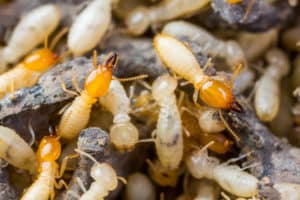Termite Inspection
Where We Look

Termites are a special breed of insect. Once they detect a food source, these relentless bugs do not stop coming, even if they do not find anything right away. These pests usually only leave trails of breadcrumbs behind. The signs of infestation, which are discussed below, are only apparent to highly trained professionals.
So, at All Solutions Pest Control, we only send specialized technicians to deal with possible termite infestations.
Naked wood near the house, such as wood piles, fences, and tree stumps, are the obvious place to start. That’s especially true if the wood is near the perimeter. Generally, termites nest in underground locations beneath streets and vacant lots. Therefore, our inspectors also spend lots of time underground, in basements and other such areas.
Next, we closely examine some common termite hot spots. Garage-house connections are one example. If this connection is made partially of wood, and it usually is, we go beyond a visual inspection. To look for soft wood, we usually tap things with a screwdriver or other object.
Termites usually remain completely underground. So, if we see evidence of an infestation near the surface, you might have a serious problem.
What We Look For
Visual inspections are at the heart of a termite inspection. Since these insects are so small, the evidence they leave behind is usually small too. This evidence includes:
Drywall Damage: Bubbled or peeled drywall always merits close attention. That usually means insect activity, though not necessarily termite activity. Other more certain signs include tiny pin holes where termites have burrowed through the drywall and fine lines which indicate subsurface tunneling.
Wing Piles: Between mid April and mid June, when the weather really starts heating up, termites swarm, searching for new food sources. If they detect food, they shed their wings and start tunneling. Wing piles are normally near the aforementioned hot spots.
Wood Damage: Doors and windows that don’t close right could indicate many things. One possibility is wood damage due to termite infestation. If that’s the case, our inspectors will probably also find tiny tunnels and cavities near the baseboards.
Trails of Mud: Mud trails might be the signature termite calling card. These tubes usually run up the side of the house, so subterranean termites can access the cellulose in your home. Sometimes, mud trails are also in the crawlspace, to connect the house to external food sources.
Generally, the best case scenario is a termite infestation that’s localized in one area of the house. The worst case scenario is a large scale infestation.
Specific Treatments
At All Solutions, our termite treatments usually use advanced termite baits .
As for baits, we deploy the Sentricon Termite Colony Elimination System. It’s one of the newest weapons in the fight against termites.
Our Dow Chemical-trained professionals bury the stations around the house. These stations use the termites’ biology against them. Normally, lead insects digest cellulose and regurgitate part of it, leaving a trail for others to follow.
When the lead termites eat the poisoned cellulose, it leaves a poison trail. But the termites keep using that path, because they are unable to locate the source of the poison.
The result is a minimally invasive termite treatment which often kills an entire colony over the course of a few months. The eco-friendly Sentricon Termite Colony Elimination System recently won the U.S. government’s Presidential Green Chemistry Challenge award.
To schedule a termite inspection with a termite control specialist, call All Solutions Pest Control at 636-486-7888.
Get a Free Estimate!
Request A Quote Today
...
Contact Us
Location :
44 Jason Ct, St Charles, MO 63304